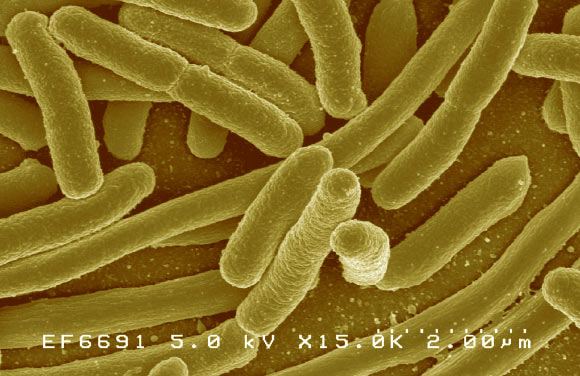Scientists from at the Scripps Research Institute have created a living Escherichia coli that has a pair of ‘alien’ DNA building blocks in its genome.

This false-color scanning electron micrograph shows Escherichia coli. Image credit: Rocky Mountain Laboratories / NIAID / NIH.
“Life on Earth in all its diversity is encoded by only two pairs of DNA bases, A-T and C-G, and what we’ve made is an organism that stably contains those two plus a third, unnatural pair of bases,” explained Dr Floyd Romesberg, who is the senior author of the article reporting the results in the journal Nature.
“This shows that other solutions to storing information are possible and, of course, takes us closer to an expanded-DNA biology that will have many exciting applications, from new medicines to new kinds of nanotechnology.”
Dr Romesberg and his colleagues have been working since the 90s to find pairs of molecules that could serve as new, functional DNA bases.
In a 2008 study, they identified sets of nucleoside molecules that can hook up across a double-strand of DNA almost as snugly as natural base pairs and showed that DNA containing these unnatural base pairs can replicate in the presence of the right enzymes. They also found enzymes that transcribe this semi-synthetic DNA into RNA.
In the new study, they synthesized a stretch of circular DNA known as a plasmid and inserted it into cells of the bacterium Escherichia coli. The plasmid DNA contained natural T-A and C-G base pairs along with the best-performing unnatural base pair the team had discovered, two molecules known as d5SICS and dNaM.
The goal was to get the Escherichia coli cells to replicate this semi-synthetic DNA as normally as possible.
“The greatest hurdle may be reassuring to those who fear the uncontrolled release of a new life form – the molecular building blocks for d5SICS and dNaM are not naturally in cells.”
To get the building blocks known as nucleoside triphosphates into the cells, the scientists used an algal triphosphate transporter. The semi-synthetic plasmid replicated with reasonable speed and accuracy, did not greatly hamper the growth of the Escherichia coli cells, and showed no sign of losing its unnatural base pairs to DNA repair mechanisms.
“The next step will be to demonstrate the in-cell transcription of the new, expanded-alphabet DNA into the RNA that feeds the protein-making machinery of cells,” the scientists said.
______
Malyshev DA et al. A semi-synthetic organism with an expanded genetic alphabet. Nature, published online May 07, 2014; doi: 10.1038/nature13314







